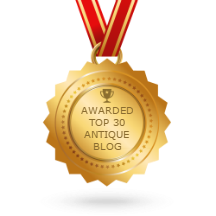Pictured below is The Buzz in the center, the Director of the Museum, Richard Deragon, second from the left, and one of Northern California's top designers, Thomas Bartlett on the right.

The topic for the Seminar was how the styles from the Renaissance to the early 19th c. impacted not only antiques but also other disciplines like painting and music.
During the Renaissance and into the Baroque period, life still primarily focused on one thing: getting into heaven and avoiding the hotter climes of hell and purgatory not to mention the suburbs like limbo.
Earthly pleasures were a sin. Fun was out. Toil and holy behavior was in. As a result, the music of the early Renaissance was primarily composed for the church—polyphonic (made up of several simultaneous melodies) masses in Latin made up their Top 40.
Likewise, the furniture was not designed for comfort--noooooo, a chair, for example, was designed to be used for two things: 1. To sit (with no regard for comfort) and 2. To communicate the status of the person who's rear-end was in the chair.
So seating in the Renaissance was not about kicking back and feelin' groovy. Comfort was for sinners. Suffering was a good thing. And so the chairs of the day had straight backs and very little in the way of cushions. Look at this late 17th c. Savanarola folding chair:


Likewise, the furniture was not designed for comfort--noooooo, a chair, for example, was designed to be used for two things: 1. To sit (with no regard for comfort) and 2. To communicate the status of the person who's rear-end was in the chair.
So seating in the Renaissance was not about kicking back and feelin' groovy. Comfort was for sinners. Suffering was a good thing. And so the chairs of the day had straight backs and very little in the way of cushions. Look at this late 17th c. Savanarola folding chair:


But how could a chair convey status in 1500? Well, you were lucky if you even got a chair. Because unless you were a person of means or a royal of some sort, you sat on the floor or, if you were "a favorite" of the person in power, you got a bench.
Another good example of a Renaissance/early Baroque chair is the caquetoire (pronounce "KAK-twar") shown here:
Another good example of a Renaissance/early Baroque chair is the caquetoire (pronounce "KAK-twar") shown here:

Comfy looking, huh?
In the Rococo, the focus turned more to having some fun while still on earth. And so what was serious and structured in the Renaissance and, to a lesser degree, the Baroque, became whimsical, curvy, and sensual. Think of the curves that pervade Louis XV furniture. Shown below: An 18th c. Louis XV Italian arbalette commode that could only be described as exuberant: 
 It's practically dancing, right?!...
It's practically dancing, right?!...

 It's practically dancing, right?!...
It's practically dancing, right?!...And in music, listen to Jean=Philippe Rameau or some of the early works of Mozart. Music was now less formal and grandiose in structure and more graceful than profound.
Sidenote: Although music contemporary with the various antique periods do in fact REFLECT (sound like/convey) those styles, they are not categorized using the same jargon as we do in antiques. For example, Rameau falls into the musical period called Baroque, Mozart is mainly in the Baroque music period also but transitions to the Classical, and Beethoven (see below) is at the close of the Classical period. To illustrate the point, there is technically no formal Rococo period in music; music of that time is called Baroque; music during the Neoclassical antique period is called Classical.
The joy and sensuality of the Rococo applied to paintings of that time as well. Take a look at the painting "The Swing" by Fragonard-it's unadulterated rococo style:

Fifty years later, Napoleon was the emperor of France and his Empire style of drama, dignified militarism, and pomp were in favor. Listen to Beethovan (in Germany no less!) and you can actually HEAR the style in his music. And here is an antique that also echoes the "style" of the period: A parcel gilt and poychrome 19th c. console table: List price: $64,250 USD
List price: $64,250 USD
 List price: $64,250 USD
List price: $64,250 USDI just hope my seminar wasn't as boring as this post (I just fell asleep proofing it). Hmmmm.









No comments:
Post a Comment